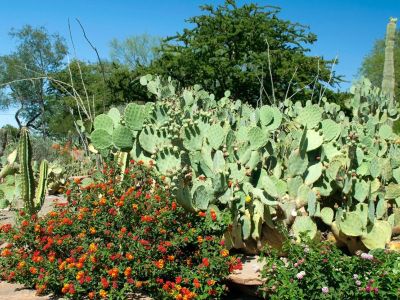People who attempt to grow plants in Las Vegas are confronted with oven-like temperatures, drying winds, minimal rainfall, and often poor soil. The rewards are mild winters, the desert vista, and the beautiful, endless sky. Read on to see what Las Vegas growing is like.
About Las Vegas Garden Design
Las Vegas garden designs are adaptable to the arid climate, often relying on indigenous plants or succulents. They are also shown to best benefit from carefully placed gravel, rocks, or natural stones. Trees are typically mesquite or other desert-loving specimens that cast a bit of welcome shade on hot days. Grassy lawns that demand water are typically small or not used at all. Outdoor furniture is normally chosen to reflect heat and stay cool. Firepits allow Las Vegas gardeners to enjoy the great outdoors on chilly evenings. Solar lights are a beautiful way to illuminate a desert garden without boosting the power bill.
Successful Gardening in Las Vegas
Prepare the soil well, as the soil is typically highly alkaline and low in fertility. One way to improve difficult conditions and improve drainage is to dig in generous amounts of compost, chopped leaves, well-rotted manure, or other organic material. Rely on mulch, which conserves moisture and keeps the soil cool. Consider gardening in raised beds if your soil is difficult. Raised beds are attractive and easy to care for. You may want to have your soil tested to determine the pH level. A test will also let you know what nutrients are present, and how deficits can be supplemented. Plant a few hardy perennials – low-maintenance plants that provide beauty for more than one season.
Vegetable Gardening in Las Vegas
Before planting veggies in the garden, you’ll want to choose those that are specifically adapted to growing in this type of harsh, desert-like environment. For instance, some tomato varieties do better than others in particularly hot climates. Likewise, if you’re wanting to grow spinach, you may want to opt for heat-loving alternatives. When to plant in Las Vegas? Here’s a quick run-down:
Summer crops like squash, cucumbers, watermelon, corn, and beans are best planted by seed directly in the garden when the soil is warm, usually in mid-to late February. Plant peas as soon as the ground thaws in January.
Start tender plants like eggplants, tomatoes, and peppers indoors in early December, then transplant them outdoors after you’re sure there is no danger of frost, usually in mid-February. Alternatively, purchase small plants.
Cole crops like cabbage, kale, and broccoli can be planted by seed directly in the garden as early as the ground can be worked in January. You can also buy small plants or start the seeds indoors in early December.
